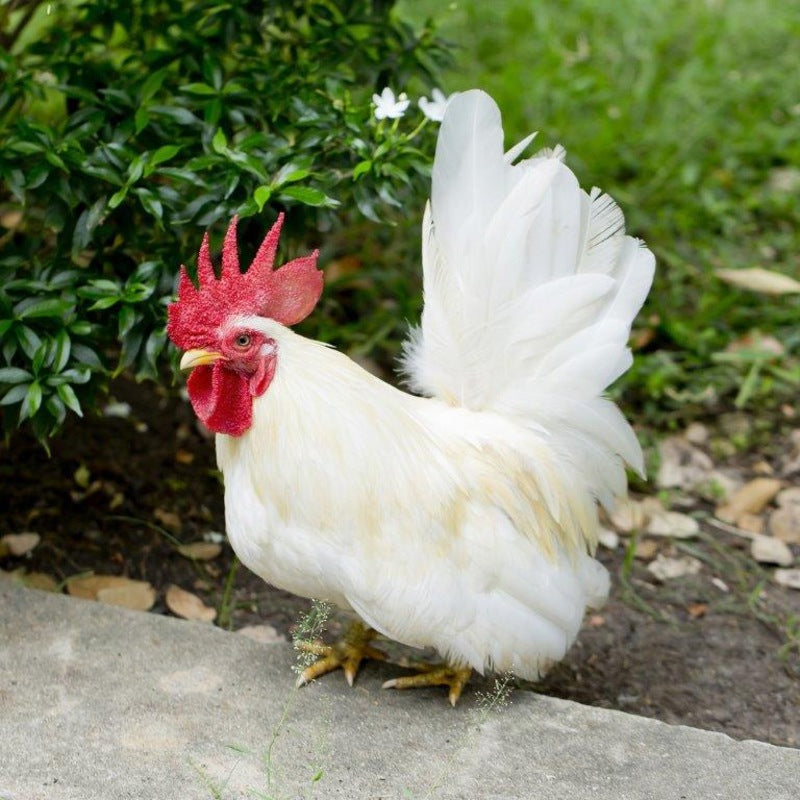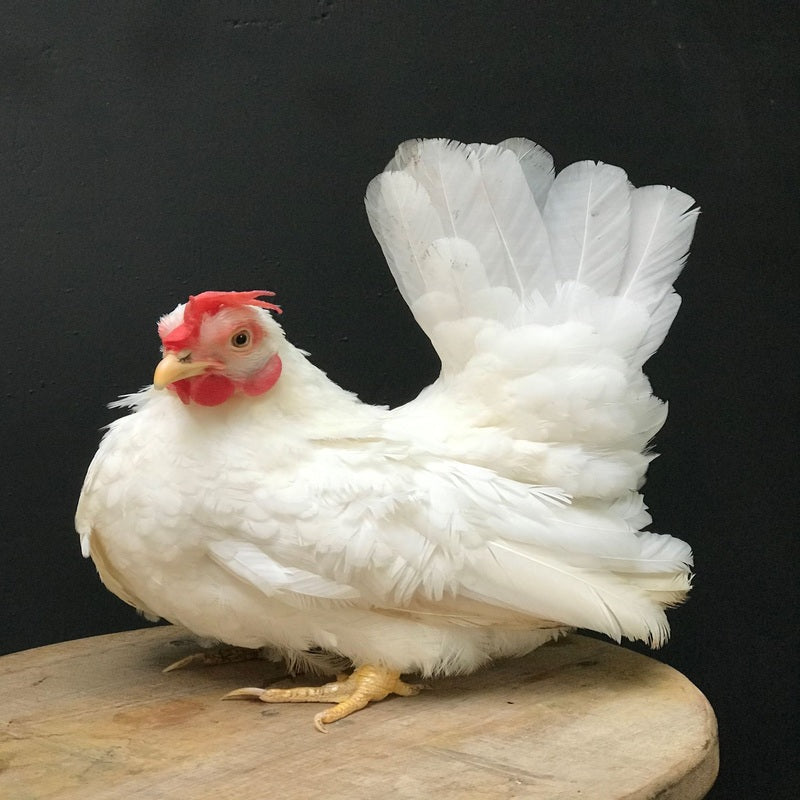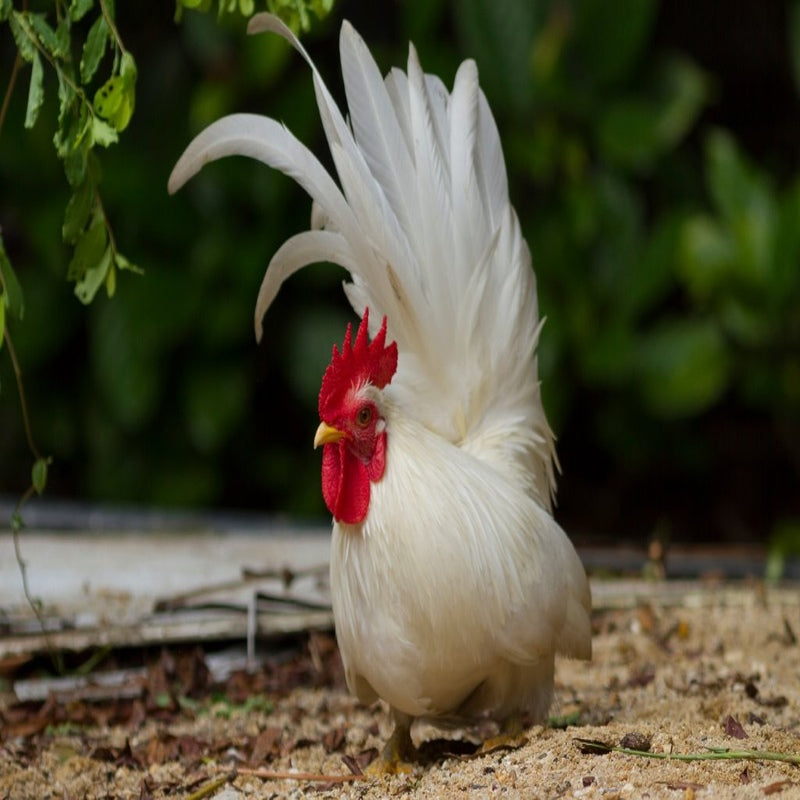-
Egg Size
Small
-
Egg Quantity
Fair (2/wk)
-
Egg Color
Cream, White, Tinted
-
Abundance
Rare
-
Cold Tolerance
Hardy In Winter
-
Heat Tolerance
Not Especially Heat Tolerant
-
Size
Bantam
-
Personality
Active
-
Feathered Feet
No
White Japanese Bantam
White Japanese Bantam Chicken
At Chicken Coop Company, we proudly offer six unique varieties of Japanese Bantams, including the elegant White Japanese Bantam. This miniature breed has a rich history, dating back to Japan in the 1700s, and has been recognized by the American Poultry Standard of Perfection for over a century.
The White Japanese Bantam stands out for its pure white feathering and distinct large comb, making it a charming addition to any flock. For more information about the White Japanese Bantam or any other variety, contact our team today!

Appearance:
-
Feather Color: As the name suggests, the White Japanese Bantam is characterized by its pure white plumage. Their feathers are smooth and glossy, contributing to their clean and sharp appearance. The overall effect is very refined and elegant, making them a popular choice for ornamental flocks and poultry shows.
-
Body Type: The White Japanese Bantam, like all Japanese Bantams, has a compact and small body. They are naturally lightweight and short-statured, which makes them one of the smallest bantam breeds. Despite their size, they are robust and proportionately well-balanced.
-
Tail: One of the standout features of the Japanese Bantam is its high, flowing tail. The tail is carried upright and is long, often creating a beautiful, sweeping arc. The White Japanese Bantam’s tail is particularly elegant, which adds to its ornamental appeal.
-
Comb and Wattles: These bantams have a small, single comb that stands upright, typical of the Japanese Bantam breed. The comb is proportionate to their small size, and they also have medium-sized, bright red wattles.
-
Legs and Toes: The legs of the White Japanese Bantam are short and yellow, adding to the bird’s overall tidy appearance. They typically have three toes on each foot, which is typical of bantams.
Temperament:
-
Friendly and Calm: White Japanese Bantams are generally friendly, calm, and relatively docile. While they may not be as affectionate as some other breeds, they are still easy to handle and enjoy interacting with their environment. Their small size makes them more manageable for handling, though they are often more independent than larger breeds.
-
Active and Curious: These bantams are curious and energetic, enjoying the opportunity to forage and explore their surroundings. They are active but not overly flighty, and they are typically very alert to their environment. They make excellent free-range chickens but should be kept in a safe area to prevent them from flying away or becoming easy targets for predators.
-
Good with Other Chickens: White Japanese Bantams are generally peaceful and get along well with other chickens in a flock. Their small size makes them less dominant, so they usually fit in well with other breeds without causing much conflict.

Egg Laying:
-
Moderate Egg Production: Like most bantams, the White Japanese Bantam is not a high egg producer. They typically lay small, white eggs, and their egg production is around 2-3 eggs per week. While their egg production may not be as high as larger breeds, they still provide eggs that are flavorful and suitable for cooking.
-
Egg Size: As with all bantams, the eggs produced by the White Japanese Bantam are small, which is typical for bantam breeds. The eggs have a delicate shell and are prized for their taste rather than their quantity.
Health and Care:
-
Hardy: Despite their small size, the White Japanese Bantam is generally a hardy and healthy breed. However, like most small bantams, they may have difficulty with extreme temperatures. In very cold climates, their small size makes them more susceptible to frostbite, especially on their combs and wattles. In hot climates, they may benefit from shade and cool areas to prevent overheating.
-
Low Maintenance: These bantams require minimal grooming or care. Their feathers are smooth, so they don’t have the same grooming needs as some other breeds. Regular checks for parasites (like mites or lice) are important, but otherwise, their care is fairly straightforward.
-
Free Range: White Japanese Bantams do well in free-range environments where they can scratch around and forage. However, because of their small size, they are more vulnerable to predators, so a secure and safe enclosure is necessary to keep them safe.
Show and Ornamental Qualities:
-
Poultry Shows: White Japanese Bantams are frequently shown in poultry competitions due to their distinct appearance, compact size, and elegant posture. Their high tail, smooth white feathers, and overall graceful look make them stand out in shows and exhibitions.
-
Ornamental Appeal: These bantams are often kept for ornamental purposes rather than for egg production, making them a favorite among poultry enthusiasts who value beauty and unique characteristics in their flock.
Frequently Asked Questions:
What is a White Japanese Bantam?
A miniature breed with white feathers and a large comb.
When did Japanese Bantams originate?
They originated in Japan in the 1700s.
Are Japanese Bantams recognized by poultry standards?
Yes, they’ve been recognized by the American Poultry Standard of Perfection for over 100 years.
Is the White Japanese Bantam available in other colors?
Yes, Chicken Coop Company offers six varieties.
What is the lethal creeper gene in Japanese Bantams?
It’s a genetic trait that affects leg development in Japanese Bantams.
White Japanese Bantam Facts
- Poultry Show Class: Single Comb Clean Legged (Other than Game) Bantams
- Weights – Hen ——-22 oz
Rooster—-26 oz
Pullet——20 oz
Cockerel—22 oz
- Purpose and Type: Ornamental; Exhibition
- Egg Shell Color: Cream or Tinted bantam sized eggs
- Egg Production: Fair
- Egg Size: Small
- Temperament: Active
- Fertility Percentage: 40-55%
- Broody: Variable
- Mating Ratio: 6 Females to 1 Male
- Roost Height: 2 to 4 feet
- Country of Origin – Japan
- APA: Yes, Recognized by the Standard of Perfection in 1883
- TLC: Yes, Threatened Status
- Breeder Farm Source: Poultry Breeding Farm has been developing our bloodline/strain of Japanese Bantam chicken breed since 1973.
Notice: We do not sell items on Amazon or other websites.








